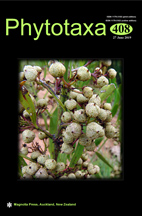Abstract
Hypnea musciformis is a red macroalgal species with economic importance as a source for production of carrageenan. Recent phylogeographic studies revealed a hidden diversity of cryptic species, putting in check its cosmopolitan distribution. The DNA barcode marker COI-5P and plastid rbcL, in addition to morphological studies, were used to investigate the species in this complex and to compare them with specimens from other countries including the type locality in Italy. The divergences between sequences within the H. musciformis complex were significantly high for both markers. Based on these analyses two new species are described, Hypnea caraibica Nauer, Cassano & M.C. Oliveira sp. nov. and Hypnea schneideri Nauer, Cassano & M.C. Oliveira sp. nov. Hypnea caraibica seems to be a common, widespread species in the Gulf of Mexico and the Caribbean and was recently introduced into Hawaii. This species was unnoticed due to lack of phylogeographic studies in the region. Hypnea schneideri seems to be more geographically restricted, but further surveys are needed to understand the distribution of this species. Because the identification of Hypnea species is complicated by their relatively simple and plastic morphology, DNA barcoding surveys and other molecular studies are essential to uncover hidden biodiversity in the genus and to supplement traditional studies based on morphology.

